Görselleştirme Yaklaşımının Matematikte Öğrenilmiş Çaresizliğe ve Soyut Düşünmeye Etkisi
Görselleştirme Yaklaşımı, Soyut Düşünme, Matematikte Öğrenilmiş Çaresizlik
The Effect of Visualization Approach on Learned Helplessness and Abstract Thinking in Mathematics
___
- Abramson, L. Y., Seligman, M. E. P., ve Teasdale, J. D. (1978). Learned helplessness in humans: Critique and reformulation. Journal of Abnormal Psychology, 87, 49–74.
- Afamasaga-Fuata´I, K. (2004). Concept Maps and Vee Diagrams in Undergraduate Mathematics Problem Solving. ICME-10, Mexico. 10th International Congress on Mathematical Education.
- Arcavi, A. (2003). The role of visual representations in the learning of mathematics. Educational Studies in Mathematics, 52, 215-241.
- Bindak, R. (2005). İlköğretim Öğrencileri İçin Matematik Kaygı Ölçeği. F. Ü. Fen ve Mühendislik Bilimleri Dergisi, 17 (2), 442-448.
- Büyüköztürk , Ş. (2004). Sosyal Bilimlerde Veri Analizi El Kitabı. 4.Baskı, Ankara: Pegem A Yayıncılık.
- Duval, R. (1999). Representation, vision, and visualization: Cognitive functions in mathematical thinking. Basic Issues For Learning. In Proceedings of the Annual Meeting of the North American Chapter of the International Group for the Psychology of Mathematics Education, Morelos, Mexico. (ERIC Document Reproduction Service No. ED 466379).
- Eisenberg, T., Dreyfus, T. (1991). On the Reluctance to Visualize in Mathematics. In W. Zimmermann ve S. Cunningham (Eds.), Visualization in teaching and learning mathematics (pp. 26–37). Washington, DC: Mathematical Association of America.
- Ersever, H. Öğrenilmiş Çaresizlik. (1993). Ankara Üniversitesi Eğitim Bilimleri Fakültesi Dergisi, Cilt: 26, Sayı: 2.
- Ferrini-Mundy, J. Principles and Standards for School Mathematics: A Guide for Mathematicians, Notıces Of The AMS, Eylül (2000),Vol. 47, No: 8.
- Gelir, E. (2009). Ana Baba Tutumları, Aile Sosyal Atomu ve Cinsiyete Göre İlköğretim Altıncı Sınıf Öğrencilerinin Öğrenilmiş Çaresizlik ve Akademik Başarılarının İncelenmesi. Çukurova Üniversitesi, Sosyal Bilimler Enstitüsü, Yüksek Lisans Tezi, Eğitim Bilimler Anabilim Dalı.
- Hançer, A.H., Şensoy, Ö., Yıldırım, H.İ. (2003). İlköğretimde Çağdaş Fen Bilgisi Öğretiminin Önemi ve Nasıl Olması Gerektiği Üzerine Bir Değerlendirme. Pamukkale Üniversitesi Eğitim Fakültesi Dergisi, (1), Sayı:13
- Hitt, F. (1998). The Role of Semiotic Representations in The Learning of Mathematics. Bills, L. (Ed.) Proceedings of the British Society for Research into Learning Mathematics, 18(3).
- Hitt, F. (Ed.) (2002). Representations and mathematics visualization. (Papers presented in this Working Group of PME-NA, 1998-2002). Mexico City: Cinvestav – IPN.
- İpek, A.S. (2003). Kompleks Sayılarla İlgili Kavramların Anlaşılmasında Görselleştirme Yaklaşımının Etkinliğinin İncelenmesi. Yayınlanmamış Doktora Tezi, Atatürk Üniversitesi, Fen Bilimleri Enstitüsü, Erzurum.
- Konyalıoğlu, A. C., (2003). Üniversite Düzeyinde Vektör Uzaylari Konusundaki Kavramların Anlaşılmasında Görselleştirme Yaklaşımının Etkinliğinin incelenmesi. Yayımlanmamış Doktora Tezi, Atatürk Üniversitesi Fen Bilimleri Enstıtüsü, Erzurum.
- Presmeg, N. C., Bergsten, C. (1995). Preference for visual methods: An international study. In L. MeiraveD. Carraher (Eds.), Proceedings of the 19th International Conference for the Psychology of Mathematics Education (Vol. 3, pp. 58–65). Recife, Brazil: Universidade Federal de Pernambuco.
- Presmeg, N. C. (2006). Research on visualization in learning and teaching mathematics: Emergence from psychology. In A. Gutiérrez and P. Boero (Eds.), Handbook of research on the psychology of mathematics education. Dordrecht: Sense Publishers.
- Pulido, R., Salinas, P. (2008). A visual approach to the graph of a two variable function and to the idea of partial derivative. Icme-11, mexico. 11th international congress on mathematical education.
- Seligman, M.E.P. and Maier, S.F. (1967). Failure to escape traumatic shock. Journal of Experimental Psychology, 74, 1–9
- Yates, S. M. (1999). Students’ explanatory style, goal orientation and achievement in mathematics: A longitudinal study. Refereed pof the Australian Association for Research in Education Conference, Melbourne, Victoria. www.aare.edu.au/99pap/yat99484.htm
- Zimmermann, W., Cunningham, S. (1991): Editor’s introduction: What is mathematical visualization. In W. Zimmermann ve S. Cunningham (Eds.). Visualization in Teaching and Learning Mathematics, (pp. 1-8). Mathematical Association of America, Washington, DC.
- Yayın Aralığı: Yılda 2 Sayı
- Başlangıç: 2010
- Yayıncı: Dokuz Eylül Üniversitesi
Öğretmen Adaylarının Gözüyle Basit Araç-Gereçlerle Yapılan Fen Deneyleri
Görselleştirme Yaklaşımının Matematikte Öğrenilmiş Çaresizliğe ve Soyut Düşünmeye Etkisi
Oya Uysal KOĞ, Oya UYSAL KOĞ, Neş'e BAŞER
Güzel Sanatlar Fakülteleri Müzik Bölümlerinde Kullanılan Viyola Metodlarının İncelenmesi
Damla BULUT, Zülfükar ÖZFINDIK
Şifreleme Etkinlikleriyle Faktöriyel ve Permütasyon Konusunun Öğretimi
Ahmet Şükrü ÖZDEMİR, Ahmet Ş. ÖZDEMİR, Fatma ERDOĞAN, Fatma ERDOĞAN
İşbirlikli Öğrenmenin Türk Öğrencilerin Popüler Müzik Tercihlerine ve Cesaret Algılarına Etkisi
